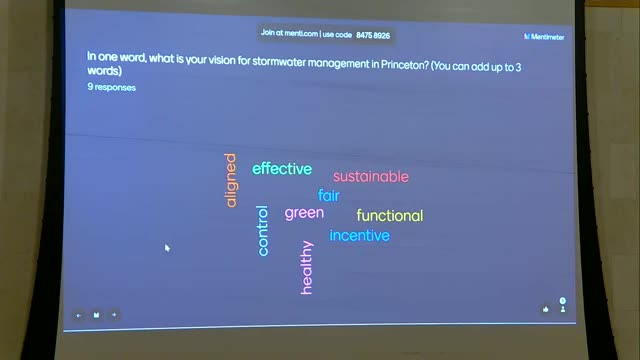Stormwater crisis demands urgent action in New Jersey
October 30, 2024 | Princeton, Mercer County, New Jersey
This article was created by AI summarizing key points discussed. AI makes mistakes, so for full details and context, please refer to the video of the full meeting. Please report any errors so we can fix them. Report an error »

In a recent government meeting, officials addressed the pressing issues of stormwater management and flooding in New Jersey, highlighting the challenges posed by increasingly intense rainfall events and aging infrastructure. Participants in a poll conducted during the meeting overwhelmingly identified flooding as a primary concern, alongside water quality issues linked to stormwater runoff.
The discussion emphasized that New Jersey is experiencing a shift in precipitation patterns, with shorter, more intense storms overwhelming existing drainage systems. This trend has led to significant property damage and public safety risks, exacerbated by increased impervious surfaces from urban development. Officials noted that many waterways, including Harrys Brook and Stony Brook, are impaired due to pollutants entering from stormwater systems.
Princeton's stormwater infrastructure, which includes over 3,000 inlets and 300 outfalls, is under strain. The municipality's public works department, responsible for maintaining this system, faces challenges due to limited funding and a lack of dedicated resources. The operational budget is capped, making it difficult to hire additional staff or allocate sufficient funds for necessary repairs and compliance with new stormwater regulations.
To address these challenges, officials introduced the concept of a stormwater utility, a dedicated funding mechanism that would allow municipalities to collect fees for stormwater management services. This model, already adopted in several other states, aims to provide stable revenue for proactive infrastructure maintenance and improvements.
As New Jersey grapples with the realities of climate change and its impact on stormwater management, the establishment of a stormwater utility could be a crucial step toward enhancing the resilience of local communities against flooding and ensuring the protection of water quality. The meeting concluded with a commitment to further explore this option and engage the community in discussions about its potential implementation.
The discussion emphasized that New Jersey is experiencing a shift in precipitation patterns, with shorter, more intense storms overwhelming existing drainage systems. This trend has led to significant property damage and public safety risks, exacerbated by increased impervious surfaces from urban development. Officials noted that many waterways, including Harrys Brook and Stony Brook, are impaired due to pollutants entering from stormwater systems.
Princeton's stormwater infrastructure, which includes over 3,000 inlets and 300 outfalls, is under strain. The municipality's public works department, responsible for maintaining this system, faces challenges due to limited funding and a lack of dedicated resources. The operational budget is capped, making it difficult to hire additional staff or allocate sufficient funds for necessary repairs and compliance with new stormwater regulations.
To address these challenges, officials introduced the concept of a stormwater utility, a dedicated funding mechanism that would allow municipalities to collect fees for stormwater management services. This model, already adopted in several other states, aims to provide stable revenue for proactive infrastructure maintenance and improvements.
As New Jersey grapples with the realities of climate change and its impact on stormwater management, the establishment of a stormwater utility could be a crucial step toward enhancing the resilience of local communities against flooding and ensuring the protection of water quality. The meeting concluded with a commitment to further explore this option and engage the community in discussions about its potential implementation.
View full meeting
This article is based on a recent meeting—watch the full video and explore the complete transcript for deeper insights into the discussion.
View full meeting
